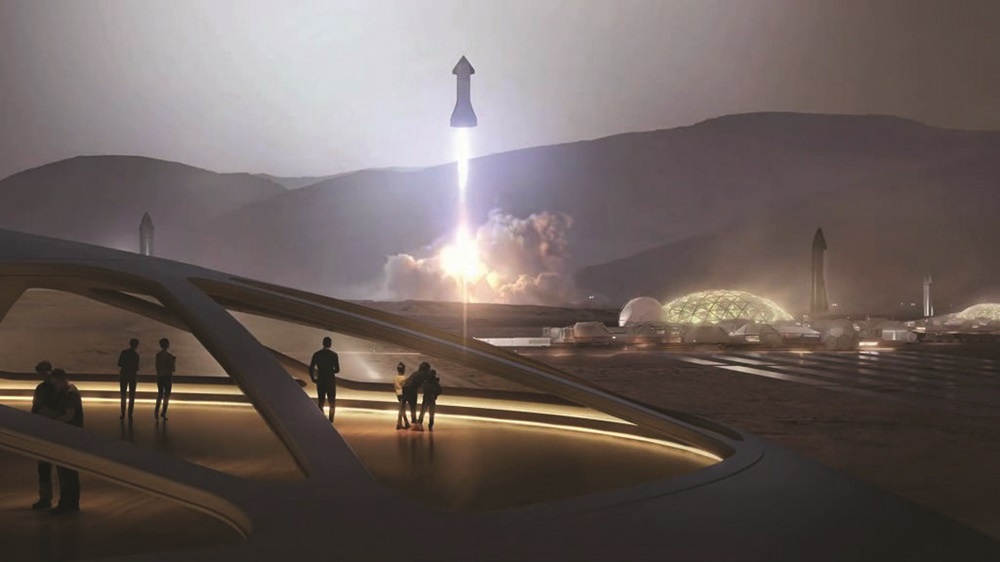Products You May Like
Want to win Elon Musk’s $100 million XPRIZE for carbon removal? Think small and think Mars.
Elon Musk and XPRIZE recently announced a $100 million prize purse for economically scalable ideas to capture and sequester carbon dioxide (CO2). As of Earth Day 2021, registration for XPRIZE Carbon Removal now open. The hope is to inspire a global industry that will “collectively achieve” gigaton-scale removal of CO2 from Earth’s atmosphere. We urgently need these solutions, as most Intergovernmental Panel on Climate Change scenarios require CO2 removal to limit global warming to 1.5 degrees Celsius.
As badly as we need this Earth-saving industry, it’s also interesting to consider its benefits for another industry: space exploration. Specifically, for contestants seeking an edge, I predict Musk will acquire an XPRIZE solution that:
- Converts captured CO2 into useful products.
- Fits inside an 8-meter-diameter compartment.
An integrated theory of Elon Musk
Elon Musk wants to go to Mars. This is common knowledge. But “going to Mars” is more than rockets. All of his projects are part of the Mars plan. Earth is only his R&D lab. His SolarCity (solar panels) and the Gigafactory (batteries) have obvious utility on Mars. Tesla (self-driving electric vehicles) offers transportation in a place with no gasoline — and potentially no humans, should Musk want to send drones to lay out the red carpet ahead of a crewed mission. Starlink (satellites) enables communication not only with Earth, but between points on Mars. Even the Boring Company (tunneling machines) has its place: Solar radiation makes the Martian surface nigh unlivable, so interconnected subterranean living quarters may be necessary. As for the not-flamethrower? We don’t know what Perseverance will find. You can’t be too safe.
How does carbon capture fit this theory?
This XPRIZE is intended to “fight climate change and restore the Earth’s carbon balance.” It has no interest in Mars, but rather in Earth-based solutions such as Carbon Engineering, Project Vesta, or Running Tide. So why is Elon Musk funding the prize? Why his sudden interest in scrubbing Earth’s atmosphere?
Resources on Mars will be hard to come by, but it has at least one in abundance: The Martian atmosphere is 95% CO2. (For reference, Earth’s atmosphere is 0.04% CO2, and the flue gases emitted from smokestacks have 25% CO2 or less.) We often think of CO2 as waste or pollution, but what if we used it as industrial feedstock? Look no further than another XPRIZE, which focuses on turning CO2 into products. With a little engineering and chemistry, you can convert CO2 to fuel, food, building materials, or other chemicals. Musk hasn’t lost sight of Mars. Far from it. He’s lying awake wondering how to supply a Martian outpost.
Of course, you need to get to Mars before you can mine its atmosphere. Everything Musk sends to the Red Planet must fit into the SpaceX Starship. The Starship has a payload compartment 8 meters in diameter and up to 22 meters high, with a maximum weight of 100 tons. You can send your technology in pieces on multiple rockets — “economically scalable” could be interpreted as modular, and modular solutions could be broken into multiple trips — but your largest component can’t exceed those specifications.
Musk’s tunnel-boring machine, named Prufrock, is a case in point. Critics from coast to coast have urged him to drill wider tunnels, to allow for municipal trains. But Prufrock, developed in-house, is only 3.7 meters in diameter (with, I estimate, a 25-ton cutting face). With those dimensions, Musk can fit multiple components into a single rocket. Like Prufrock, a Martian carbon capture solution should fit in the Starship.
You don’t need to win to win
This XPRIZE challenge will last four years, ending midway through the most environmentally consequential decade of our lifetimes. I can’t wait to see the creative solutions it inspires in the carbon capture field. Winning teams will need to capture and store one ton of CO2 per day, while convincing judges they can economically scale to a billion tons over time. That is an aspirational goal, and solutions will likely take many forms.
Some of those solutions may be portable or modular, and will produce a product to offset operating costs. I hope and expect that this XPRIZE will advance both CO2 capture and space exploration. You can be certain Musk will be watching closely for ideas that support his extraplanetary ambitions. Not everyone can win the XPRIZE cash, but give Musk something he can take to Mars and he might just bring you along for the ride.
Alex Urquhart is committed to a decarbonized future. He lives in Maine, where he works on solar project development. Previously, he worked on CO2 sequestration and radioactive waste storage issues at Sandia National Labs.
[embedded content]
